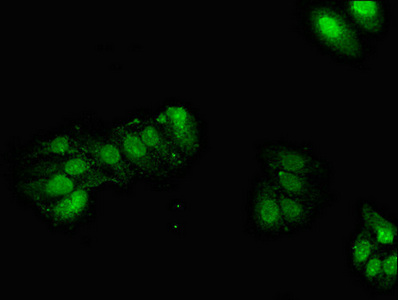
WB analysis of human liver lysate using GTX56140 GPX2 antibody, Internal. Dilution : 0.5microg/ml Loading : 30microg protein in RIPA buffer
GPX2 antibody, Internal
GTX56140
ApplicationsWestern Blot
Product group Antibodies
TargetGPX2
Overview
- SupplierGeneTex
- Product NameGPX2 antibody, Internal
- Delivery Days Customer7
- Application Supplier NoteWB: 0.5-2microg/ml. *Optimal dilutions/concentrations should be determined by the researcher.Not tested in other applications.
- ApplicationsWestern Blot
- CertificationResearch Use Only
- ClonalityPolyclonal
- Concentration0.50 mg/ml
- ConjugateUnconjugated
- Gene ID2877
- Target nameGPX2
- Target descriptionglutathione peroxidase 2
- Target synonymsGI-GPx, GPRP, GPRP-2, GPx-2, GPx-GI, GSHPX-GI, GSHPx-2, glutathione peroxidase 2, gastrointestinal glutathione peroxidase, glutathione peroxidase 2 (gastrointestinal), glutathione peroxidase-related protein 2, phospholipid hydroperoxide glutathione peroxidase GPX2, selenoprotein GPX2
- HostGoat
- IsotypeIgG
- Protein IDP18283
- Protein NameGlutathione peroxidase 2
- Scientific DescriptionThe protein encoded by this gene belongs to the glutathione peroxidase family, members of which catalyze the reduction of organic hydroperoxides and hydrogen peroxide (H2O2) by glutathione, and thereby protect cells against oxidative damage. Several isozymes of this gene family exist in vertebrates, which vary in cellular location and substrate specificity. This isozyme is predominantly expressed in the gastrointestinal tract (also in liver in human), is localized in the cytoplasm, and whose preferred substrate is hydrogen peroxide. Overexpression of this gene is associated with increased differentiation and proliferation in colorectal cancer. This isozyme is also a selenoprotein, containing the rare amino acid selenocysteine (Sec) at its active site. Sec is encoded by the UGA codon, which normally signals translation termination. The 3 UTRs of selenoprotein mRNAs contain a conserved stem-loop structure, designated the Sec insertion sequence (SECIS) element, that is necessary for the recognition of UGA as a Sec codon, rather than as a stop signal. Alternatively spliced transcript variants have been found for this gene. [provided by RefSeq, Jul 2016]
- Storage Instruction-20°C or -80°C,2°C to 8°C
- UNSPSC12352203




